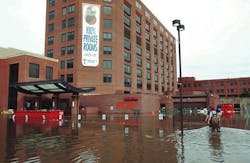Flood of 2008: Mercy Medical Center
When word first spread in early June that Cedar Rapids' downtown area could flood, no one imagined that Mercy Medical Center, located nearly three-fourths of a mile from the river, would be impacted. Professionals at Mercy Medical Center, which is comprised of seven connected buildings that total nearly 800,000 square feet, had never incorporated flood-related measures into the disaster plan. "We're not even in the 500-year floodplain here in Cedar Rapids," says Bob Olberding, director of plant operations at Mercy Medical Center in Cedar Rapids. As the river swelled, however, Olberding realized that flooding at Mercy, which had always seemed unlikely, was imminent.
The Timeline of Events
On the morning of Thursday, June 12, the day before the Cedar River crested, Olberding contacted civil engineers, verifying the elevation (727.7-feet above sea level) of the ground floor. If the hydrologist's predictions were correct, Mercy was nearly 4-feet above the forecasted crest. Unfortunately, predictions - as this situation proved - aren't always right.
The first sign of the impending flood at Mercy was the loss of power from the local utility. The facility started emergency back-up generation early Thursday morning. Dealing with what happened next - sewage back-up - wasn't nearly as simple. "I had about 40 plumbers come in from three different firms. We had to pull every stool off of the wall on the ground floor and put in air bladders to stop Category 3 water [which contains sewage and other contaminants] from backing up into our facility," Olberding explains. Just as this work was completed, sinks began backing up. With sink drains capped, all eyes were on the rising river. "Then, they predicted a 26-foot crest. The facility was basically good until a 28-foot crest," remembers Olberding. "It became apparent by 7 p.m. on Thursday that the hydrologists had missed their original prediction by about 8 feet." Instead of having a 4-foot leeway, it was now possible that Mercy could have 4 feet of water on its ground level.
Too much water in the hospital's basement would've compromised emergency generators and stranded patients on upper floors. With the river still rising, the decision was made to evacuate on Thursday evening.
With a 5-foot levee of sandbags (built by hospital employees and community volunteers) around the front of the facility and at other entrances, as well as gas pumps and improvised sump pits to collect and pump water back over the sandbags, the damage was contained. "We kept all of the water on both the ground-floor and basement levels between 2 and 4 inches, so we were able to keep our switchgear dry," says Olberding. The 2-story glass walls in the hospital's lobby held, too.
Tips and Advice
With quick thinking and wise decision-making, Olberding and his team minimized damage, swiftly began recovery efforts, and learned from the experience. Several of the best practices that were applied - along with some tips and advice - follow:
-
Prioritize by thinking about what systems are most critical to business continuity. "You may lose some small battles, but you really have to concentrate on the big picture. My biggest goal was keeping our electrical distribution dry. I knew that, if the electrical distribution was impacted by floodwater, it would probably be 6 months to 1 year to get back up and running," says Olberding.
-
Anticipate a labor shortage and line up contractors early. The 2 to 4 inches of water in Mercy's ground level and basement required replacement of damaged drywall, casework, and doors. "The Monday after the flood, we tried to reserve sheetrock workers and other contractors who we knew we would need in a month," says Olberding.
-
Be aware of where the facility's sanitary system drains; during a flood, be prepared to somehow stop backward flow.
-
Know where all basement floor and exterior wall penetrations are and, if possible, seal them. "There were some penetrations where conduit was coming through the floor that allowed water into the lower level and caused more damage downstairs than you would expect," explains Olberding. In the process of rebuilding, problematic penetrations are being addressed.
-
Meet after the disaster to discuss what went right and what can be improved. Olberding, physicians, and staff gathered to adjust plans based on recent events. "We've had meetings and debriefings while things are still fresh in people's minds on what we could change," he says.
The agility and dedication of Olberding and his staff enabled the hospital to resume operations quickly. Mercy began accepting patients again - with limited operation - as early as June 19 (less than 1 week after the river crested). It resumed full operation, admitting patients to its emergency department, on July 2. By Sept. 25, all displaced or relocated departments had returned to their original areas.
New reports are labeling the disastrous flooding in June as a "1,000-year flood." While history isn't likely to repeat itself anytime soon, Olberding isn't taking any chances. At press time, the hospital was investigating several projects that could reduce the damage and impact in the event of a future flood. "I'd never say ‘never' again," he says.
More Flood Stories:
-
Mercy Medical Center - By Jana J. Madsen
-
Alliant Energy Tower - By Jenna M. Aker
-
The University of Iowa - By Leah B. Garris
-
City of Cedar Rapids - By Jenna M. Aker
-
Guaranty Bank & Trust - By Linda K. Monroe
-
Quaker Oats - By Jana J. Madsen
-
Cedar River Tower - By Linda K. Monroe
Jana J. Madsen ([email protected]) is editor at Buildings magazine.


